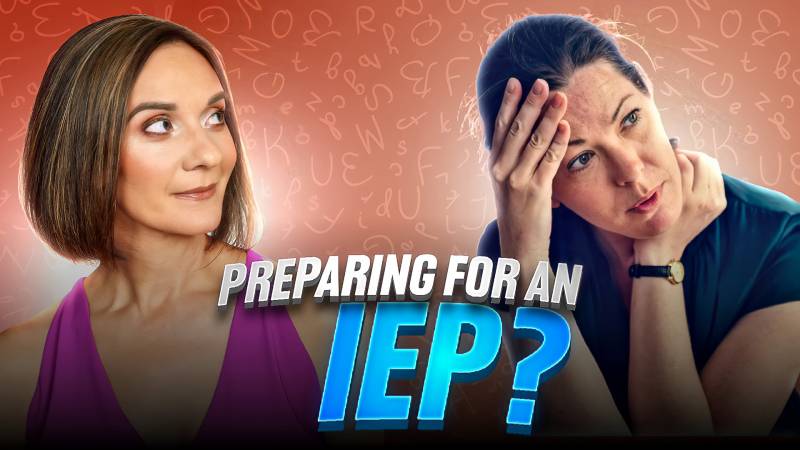
Is your child in need of an Individualized Education Program (IEP)? If so, it's crucial to be well-prepared for the upcoming IEP meeting. Not preparing could mean your child misses out on important help for their education. We'll guide you on preparing for the IEP meeting to support your child's education. We'll guide you on preparing for the IEP meeting to support your child's education.
Preparing For An IEP Meeting?
If you have decided that your child needs an IEP, then it's time to prepare for IEPs. Failing to prepare is preparing to fail. This video will go through all the important ways you need to be prepared so you can get what you want for your child. When going to an IEP meeting, you will be up against a committee that is far more accustomed to IEP meetings than you are. They've been through it hundreds of times, and they may or may not agree with you on what your child needs. So, if you are not well-prepared, you are not going to do well. They might steamroll you over, and your child will not get what they need.
Understanding the Eight Steps in the IEP Process
First, you must familiarize yourself with the eight steps in the IEP process. Step number one is requesting an evaluation in writing. There are templates available online where you can find a template to request an evaluation in writing. You want to request evaluations for any areas of concern, such as education, cognitive, occupational therapy, or speech evaluation.
Actual Evaluations and Determining Eligibility
The second step is the actual evaluations. The school has a timeline to get your child assessed. After the evaluation, they determine eligibility based on 13 codes under IDEA. Once eligibility is determined, they must create and develop the IEP. You, as a member of the IEP team, have some input and say when they develop the IEP.
Implementing the IEP and Monitoring Progress
The fourth step is implementing the IEP. It's one thing to have it all nice and in writing, but they must implement the IEP, and your child must receive their services and accommodations. The next step is monitoring progress and reviewing progress. You should continuously look at your child's homework and the work they bring home, and review it to see if you recognize any patterns and progress.
Annual Review and Reevaluation
The sixth step is your annual review. At the end of the year, you should be prepared and ready to discuss what worked, what did not work, and what changes you would like to see. The last step is reevaluation, where you must reevaluate your child's progress and ensure they are on the right track.
Preparing for the IEP Meeting
For the IEP meeting, create a list of the support and accommodations your child needs. Keep all important papers in a binder and learn IEP meeting terms to talk well with school staff.
Behavior Intervention Plans and Positive Reinforcement
Behavior Intervention Plans (BIPs) are essential when addressing problem behaviors. Make sure your child's BIP teaches them a good way to express their feelings and needs. Positive reinforcement is crucial in teaching and reinforcing new behaviors.
Parent-Teacher Communication
Keep a good line of talk with teachers and be kind when discussing your child's needs. Involve your child in the meeting if possible, as their input and perspective are valuable. Keep your child's school papers updated for correct info during meetings.
Key Takeaways:
Embracing Cultural Competence: Enhancing the IEP Process Through Family Dynamics and Cultural Considerations
Every kid's school journey is shaped by their family and culture. Knowing this helps make a good learning plan. This blog talks about why understanding cultures is important in making these plans. Also how it can make school better for the kid.
Understanding Family Dynamics:
Family dynamics play a pivotal role in shaping a child's learning and development. Teachers and IEP teams should understand each student's family and values. Working with parents helps everyone.
Embracing Cultural Considerations:
Diverse cultures make school fun and bring fresh ideas to lessons. Thinking about culture is key to make sure a kid's learning is respectful. Understanding culture makes students feel valued and boosts learning results.
Competent Assessment:
Cultural competence extends to the assessment phase of the IEP process. Standard tests might miss a kid's real skills, especially with cultural bias. aware assessments give a better view of their strengths and struggles.
Communication and Language Considerations:
Language issues can be tough in the IEP process. Interpretation services and native language materials can help parents understand better.
Celebrating Diversity in Education:
Inclusive education doesn't accept differences, it values diversity. It makes learning richer and lets kids express their unique selves.
Building a Competent IEP Team:
A competent IEP team comprises individuals who understand and embrace diversity. Having diverse professionals can boost cultural sensitivity. Training can help educators handle cultural aspects better.
Are you struggling with preparing for your child's IEP meeting? Then the Learning Success System is the answer. Discover the power of the Learning Success System and help your child overcome specific learning disabilities such as dyslexia, dyscalculia, or dysgraphia. Our do-at-home educational therapy program offers simple, exciting activities that improve cognitive micro-skills, visual and auditory processing, and more. With just 15 minutes a day, you can help your child build the confidence, grit, and focus they need to excel in school and in life.
Try our FREE trial today and see the difference for yourself!
Learn everything you need to know about IEP's in this new documentary.
Get the full documentary here
Or watch on Amazon Prime Video









